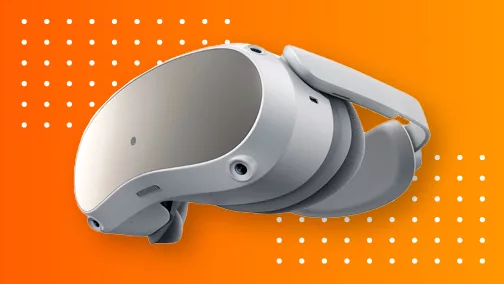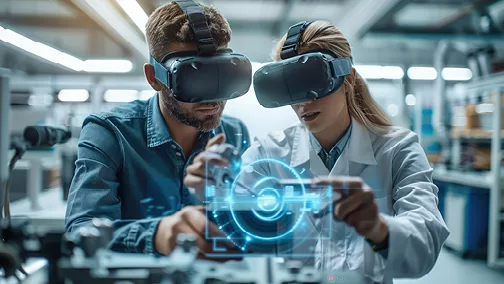On September 18th, Emile, one of our lead developers, had the opportunity to participate in a workshop organized by MATTS DIGITAL, focused on the latest innovations from PICO, a key player in the virtual reality (VR) headset market. This day allowed us to explore PICO’s ambitions for 2024 and the products that will shape the industry.
PICO, an expanding player
Since its arrival on the European market in 2017 with the PICO Neo and Goblin models, PICO has continuously innovated, launching seven models in just six years, including the Neo 2 (2019) and Neo 3 Pro (2021). Today, the brand has established itself as one of the three leading VR headset manufacturers in the world, with particular expertise in standalone headsets.
PICO primarily targets the B2B market, particularly in the sectors of education, industry, and healthcare. With headsets offering both 3DoF (three degrees of freedom) and 6DoF (six degrees of freedom) experiences, the brand caters to users seeking more immersive interactions in virtual environments. The 6DoF, for example, allows for full movement in space, while the 3DoF restricts interaction to head rotation.
One of PICO’s strategic ambitions is to move from the proof of concept (POC) stage to large-scale deployments. This includes managing fleets of headsets for businesses, a crucial aspect for organizations looking to integrate VR into their processes on a large scale. Among PICO’s competitive advantages are the absence of personal data collection, the ability to use headsets without needing to create a user account, and the option to customize headsets on demand.
PICO 4 Ultra: performance at its peak.
During the workshop, PICO unveiled its latest model, the PICO 4 Ultra, designed to compete directly with Meta’s Quest 3. Equipped with a Qualcomm Snapdragon XR2 processor, 12 GB of RAM, and 256 GB of storage, this headset boasts impressive technical specifications. It is compatible with OpenXR, a standard that facilitates the development of cross-headset applications, and supports Wi-Fi 7 for ultra-fast connectivity. With integrated mixed reality features (access to the front camera, hand tracking, etc.), the PICO 4 Ultra provides a high-quality immersive experience.
Compared to the Quest 3, the PICO 4 Ultra stands out with greater memory, a better front camera, a larger screen, and extended battery life. Although its price is higher (€695 compared to €450 for the Quest 3), it includes all the necessary features without additional costs, making it a turnkey solution for businesses and minimizing barriers to adoption.
PICO 4 Tracker: innovation in motion
Among the other new features unveiled, the PICO 4 Tracker particularly caught attention. This motion sensor, weighing only 14g, is compatible with all PICO headsets. With a battery life of 25 hours and calibration in under 10 seconds, it offers superior performance compared to its direct competitor, the HTC Ultimate Tracker. Priced competitively at €89 per pair (compared to €239 for the HTC model), this tracker could quickly establish itself in the market.
Software solutions tailored to the needs of businesses.
In addition to hardware, PICO provides software solutions designed to optimize the use of its headsets. One of these solutions allows users to scan and share environments in mixed reality for multiplayer applications (LBE – Location Based Entertainment). Although this feature requires a server or cable for sharing, it opens up numerous possibilities for businesses looking to create immersive collaborative experiences.
The PICO Business Suite offers comprehensive tools for managing a fleet of headsets locally. Content synchronization, kiosk mode, remote communication: everything is designed to simplify the management of multiple headsets in professional contexts such as training or presentations. PICO also announced the upcoming launch at the end of the year of the Business Device Manager, a solution similar to ArborXR, allowing for remote management of headset updates and commands.
The PICO 4: a major asset for VR and mixed reality.
The PICO 4 stands out in both virtual reality and mixed reality. In VR, it delivers superior performance thanks to its Qualcomm Snapdragon XR2 processor and 128 GB of memory. These features make it an ideal tool for intensive applications such as training, simulation, and virtual collaboration. The comfort and ergonomics of the headset, with optimized weight distribution, allow for long immersive sessions without discomfort.
In mixed reality, the high-resolution front camera of the PICO 4 enables seamless integration of virtual elements into the real world. This feature is particularly suited for sectors like architecture, where 3D plans can be overlaid on real environments, or maintenance, where technicians can follow instructions in real-time. Thanks to the OpenXR standard, applications developed for the PICO 4 are compatible with a wide range of headsets, making this model particularly attractive for businesses.
Conclusion
This workshop confirmed that PICO continues to establish itself as a leader in the virtual reality market, with a strong B2B focus. Their solutions, both hardware and software, meet the specific needs of companies looking to deploy VR and mixed reality on a large scale. With products like the PICO 4 Ultra and the PICO 4 Tracker, the brand is positioning itself as a key player to watch in the coming years.


